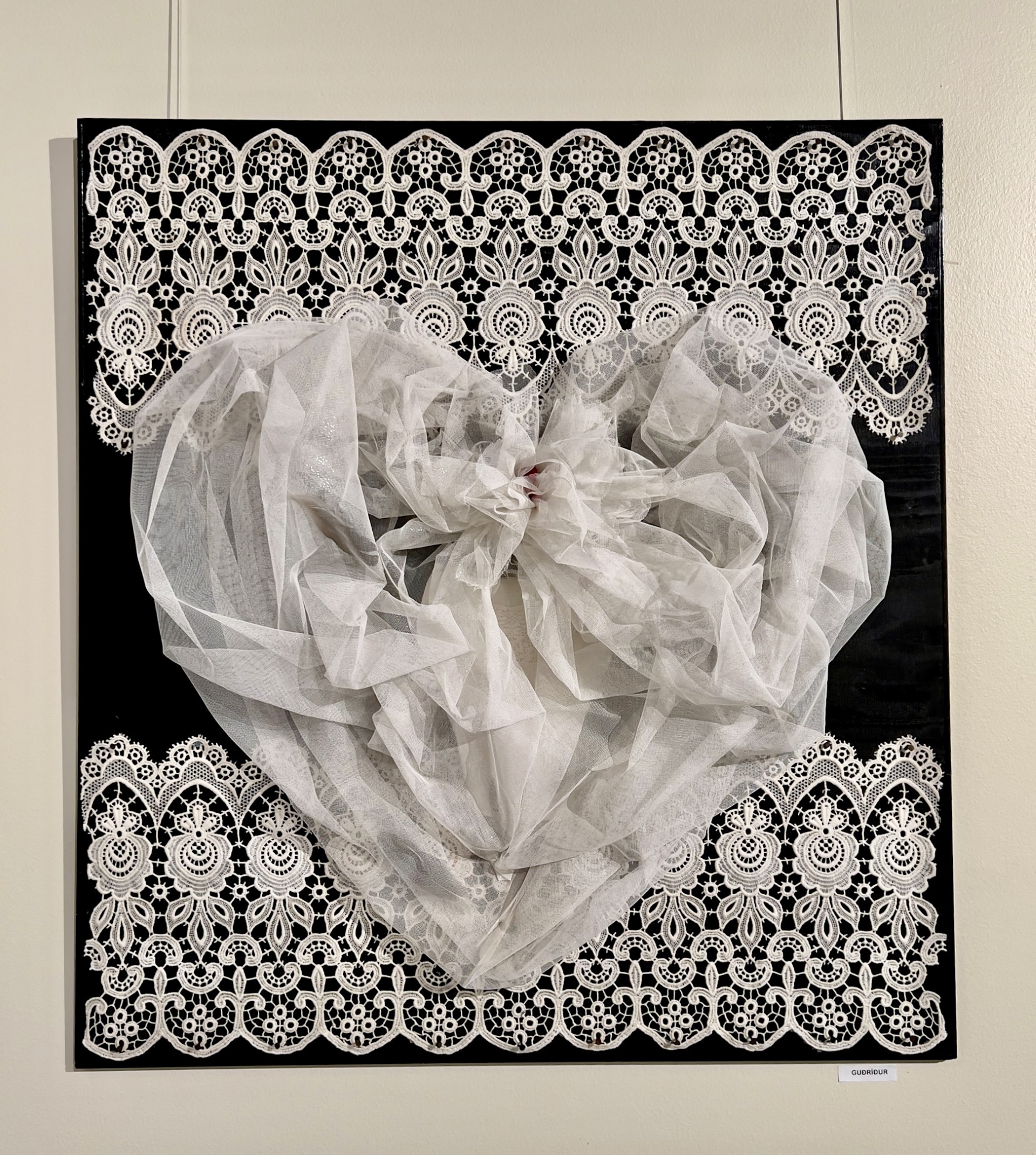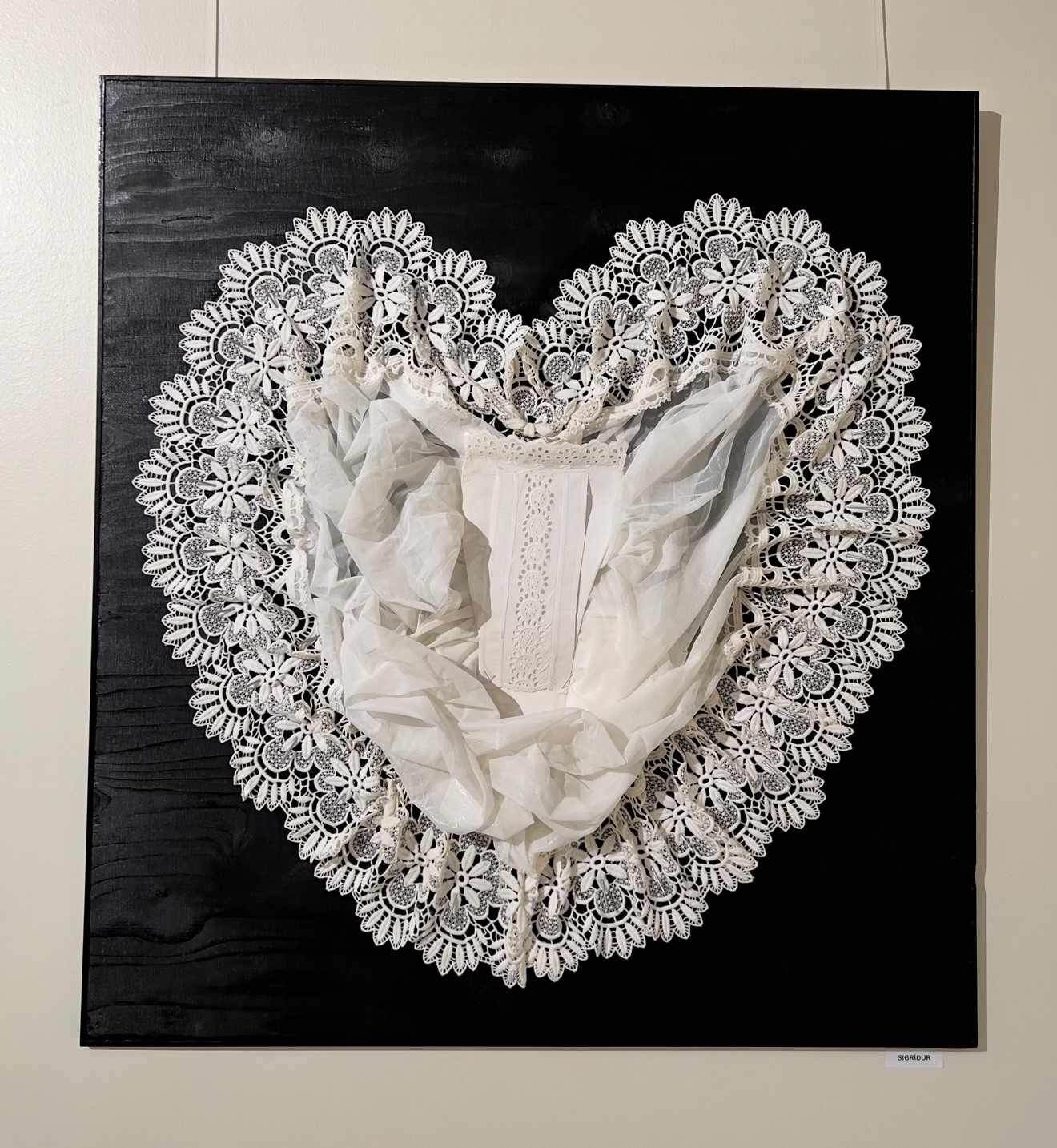
Women's Prime | „This is the life I want to live“
Artist's Þórunn Elísabet Sveinsdóttir, Tóta, solo exhibition, Women's Prime, at Reykjavík City Library Spöngin October 14th - January 10th.
“When I was a little girl I thought “stórris“ (a funny Icelandic word that sounds a bit like stór risi which means a big giant and means long curtains made out of laces) was a very strange word, but over the years I have often worked with "big giants" in my works. At this exhibition there are laces, which women waited to be able to on until after the children were asleep at night. What I think is beautiful about working like this is that you take the time and release it to yourself and play with your emotions based on that. That's why the exhibition is called Kvennablóminn. (e. The women's blossom).“
Says Þórunn Elísabet Sveinsdóttir or Tóta as she is most often called, about her exhibition which is currently on at the City Library Spöngin.
Tóta studied art at the Iceland School of Art and Handicrafts and has held numerous exhibitions around the country. She has also worked as curator and as a costume and set designer in theaters. She has received the Gríma award for the plays Sjö ævintýri um skömm, Rómeó og Júlíu Vesturports and Leg. Tóta has also worked in the film industry and among the films she has worked on that have appeared on the big screen are 101 Reykjavík, Ikingut and Hafið.
“For me, this is about how time is kept and this need to make something beautiful. I am very romantic myself and have gone through many “white periods“, I like to use textiles, curtains, old national costumes, laces and other things that I find. For example, there is one loose white collar at this exhibition that was put on different dresses to make them look nicer, and then the collar or the garments could be washed. All things were more expensive before and people didn't own that much.“

Has nothing to do with common sense
Asked if the exhibition is in any way related to the strong discussion in the society about environmental protection and the women's and non-binary strike in October Tóta says that it was not the original thought.
“But sometimes you are just at the right time, in the right place. It's usually so that I don't know it myself. Sometimes I just start somewhere and I don't really know why, but then it all comes together. You know how the brain works, you all of a sudden you are just like, yes! this could be fun, and then it just loads up. I have lots of boxes that I throw things in that come my way but the good thing is that I empty them regularly. Sometimes, however, I have collected something specific for up to 50 years. Then sometimes the emphasis changes and then I just let the stuff fly elsewhere. Some ideas fade away too, it can sometimes be weird to keep an idea for too long. I think it's like fashion, no one knows where it comes from but it happens all over the place at the same time. I have definitely experienced it but then maybe a little later comes, no!, and then the moment is gone. I don't know if one should be too aware of it. You exist in the moment and then maybe it lives on and then maybe it just doesn't. It has to do with the moment, the zeitgeist, the feeling and the experience, not necessarily the common sense. But it sure helps with this connection with the brain.“
Tóta says she doesn't settle in between art forms, each one of them has its own charm. Women's heritage occupies a large place in her work, just like at the exhibition in Spöngin, but she also likes to work with paper and buttons and no less nails and wood, in the spirit of her grandfathers who were upholsterers and carpenters.

Lucky to get the hippies and punk straight into the vein
But even though Tóta works a lot with women's heritage, she isn't much into sewing tablecloths or crocheting blankets.
“I'm way too much of a hippie for that, I was more into cutting up material and making clothes for my children that way. Maybe a bit like I belonged more to the women of the generation before me. I feel lucky to be living these times, to be born into the hippie generation and get this straight into my veins, and then punk. And then go to art school at this time, the modern art department. This is necessarily about what I learned at the school itself, but also from fellow students, there were so many geniuses, older people and younger people, for me it matters. I think that's a big part of my work, I'm always handling with time and bringing some story forward. I am a living collection dump.
In the theater, the ideas or the approach spring from the text. I begin by defining how much can be seen and then separate, day and night, wealth and poverty, sadness or joy. Next is the agreement, first with those who are artistic directors, then with the actors. It all depends on the text and the listening, how we expose it.“
Tóta says Kvennablóminn, Women's prime is her private drama, it is not many individual works but one big installation and all the pieces bear the names of women, the artist's mother-in-law and grandmother's sister, and names such as Hallgerður, Snæfríður, Briet and Sigríður (all women who play a roll in Iceland's history).
“I think of this as an altar dedicated to women who have passed away, all of them exept for two . So it goes way, way back. In a way, this is my tribute and gratitude to these women. We must emprace love however we can, there is no other way, we cannot enter the violence.“

Public spaces are so great
But how does a library work for the artist as an exhibition space?
"Very well, public spaces are so great because everyone comes there, people are so different that you might be able turn on the interest light in anyone going through."
These days, Tóta is mostly working with nails and wood.
"I started when I was a little kid gluing all kinds of things together and nailing timber together. If I'm not working, I get bored. This is the life I want."